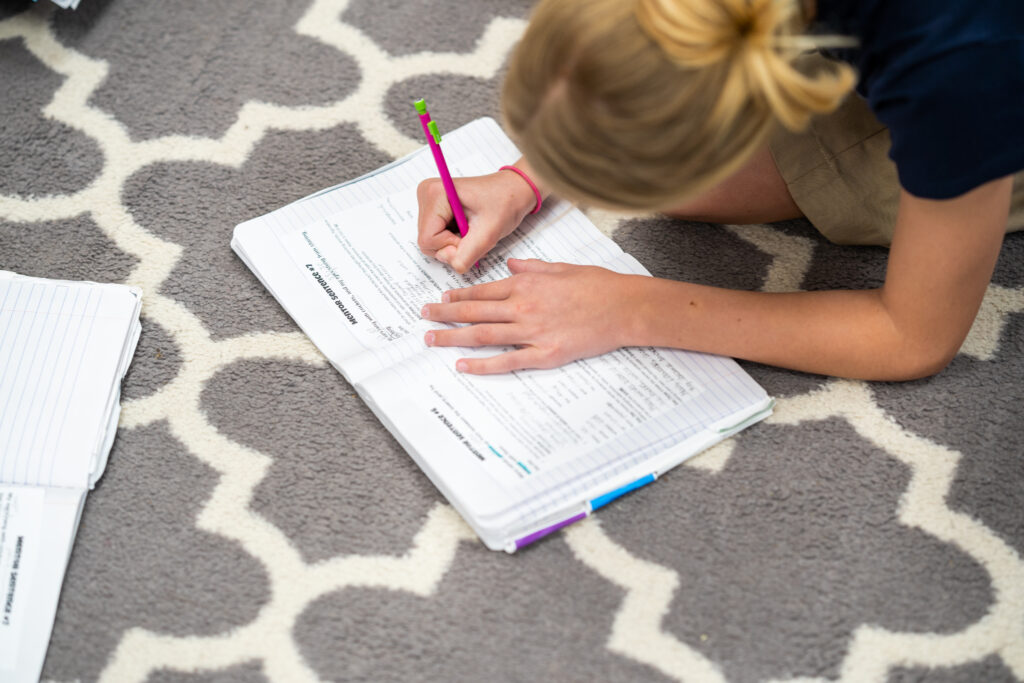Writing is a foundational component of lower school curriculum. From book reports to personal narratives, writing encourages young learners to be creative and explore abstract concepts, ideas, and stories.
While lower school students develop writing skills in the classroom, writing at home is also valuable. At St. Timothy’s School, we promote curiosity, discovery, and creativity by teaching students to write for different purposes and audiences. Below, we’ve compiled a list of ways to help your child improve their writing skills outside of school.
Encourage Reading
For young learners, reading and writing go hand in hand. Books serve as a precursor to writing: exposing children to new words, ideas, and storytelling styles that they can later adopt in their writing. Better yet, if your child reads various book genres, such as a balance of fiction and non-fiction, they can develop a more diverse set of writing styles and concepts.
As a parent, you may need clarification on which books cater best to your child’s reading level. A good rule of thumb is to ask your child’s teachers what book series they recommend. For example, first-grade readers may need to start small and work their way up to lengthier books with more complex storylines. In this case, you may even consider reading books with your child, allowing them to ask questions about vocabulary or storylines they might not understand.
Start Journaling
Journaling is an effective way to encourage writing at home. Children can use journals to express their creativity and develop their writing style, whether they write daily reflections or imaginative stories. Journaling is often most beneficial when children write in small, frequent sessions. For example, if your child does a journal entry before bed each night, they will progressively build vital writing skills and form healthy habits. Additionally, journaling can also strengthen a child’s emotional intelligence, as they can use writing as an outlet for their innermost thoughts and feelings.
Provide Writing Prompts
Writing prompts are a great solution if your child struggles to find creative inspiration. Many journals incorporate prompts and ideas to stimulate children’s imaginations and motivate them to write. These prompts can range from specific questions like “What is the best thing on the school playground?” to broad concepts like “What would you like to invent?” You can also prompt your child to write using other mediums, like interesting signs, advertisement visuals, or even just posing a question at the dinner table. If your child is apprehensive about writing, these thought-provoking questions will help them get started.
Practice Storytelling
Storytelling is the root of creative writing, and it’s a great place to start when easing your child into writing. By allowing your child to express their imagination through oral storytelling, they can develop the skills to piece together details thoughtfully. You can even build stories with your child by taking turns piecing together the story, helping your child when they get stumped on their next sequence. The ultimate goal is for your child to get creative with their thoughts and drive a story in a way that could eventually translate onto paper.
Play Word Games
Interactive word games are a great way to disguise writing and comprehension exercises as play. These games often incorporate robust vocabulary and creative writing activities, exposing children to new words and concepts that could inspire them to write. If your child is particularly competitive, they’ll be intrinsically motivated to learn new words and compete. If your child isn’t competitive, word games also can offer team-oriented options that allow them to play without the competitive aspect.
Writing, reading, and comprehension are pillars of the research-based curriculum at St. Timothy’s School. Our students explore new realms of creativity and curiosity through whole class, individual, partner, and small group instruction that incorporates creative writing concepts. Visit our site today to learn more about the comprehensive curriculum at St. Timothy’s School.


